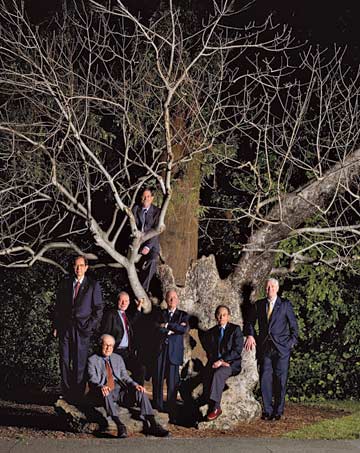UC Berkeley Web Feature
| Turning day to night with artificial lights, the Vanity Fair photo spread features Berkeley Nobel laureates (from left) Yuan T. Lee, Donald Glaser, Daniel McFadden, George Smoot, Charles Townes and Steven Chu, joined by Chancellor Robert Birgeneau. (Photo by Todd Eberle/ Vanity Fair) |  |
UC Berkeley's 'Tree of Wisdom' featured in Vanity Fair
 BERKELEY – UC Berkeley's Nobel Prize winners and Chancellor Robert Birgeneau are featured as part of Vanity Fair magazine's "Green Issue," hitting national newsstands today.
BERKELEY – UC Berkeley's Nobel Prize winners and Chancellor Robert Birgeneau are featured as part of Vanity Fair magazine's "Green Issue," hitting national newsstands today.
The magazine's May issue, which is devoted to articles about threats to the environment, also includes a 28-page portfolio highlighting the activists and scientists who are "propelling a cultural turnaround." The section includes a full-page on "The Tree of Wisdom" at Berkeley.
| Shooting the shoot |
| Roxanne Makasdjian, Public Affairs' manager of broadcast communications, was on hand to videotape the day's events:
|
Vanity Fair was on campus for the packed "Discover Cal" event on Jan. 20, where six of Berkeley's seven living Nobel laureates gave their perspectives about global warming and energy sustainability. (Economics prize winner George Akerlof was out of town.) The luminaries were then led to Faculty Glade, where they posed for photographs around (and on) the striking California buckeye tree.
Accompanying the portrait, Vanity Fair had this to say about the campus and its leading scientists:
"Berkeley, with its vast scientific and human resources, is quickly moving to establish itself as the nation's premier academic institution for the discovery and delivery of alternative energy. From 1930, when the possibility of splitting the atom was first suggested on campus, to the 1970's, when Professor Art Rosenfeld pioneered energy-efficiency standards that have saved American consumers an estimated $200 billion, Big Science at Berkeley has often provided the scientific know-how behind the state's strict regulations.In January, six of the school's seven Nobelists - including Charles Townes, the 91-year-old father of the laser, and George Smoot, who discovered a way to accurately measure cosmic background radiation from the early universe - gathered to lecture on energy self-sufficiency in the 21st century. Economics laureate Daniel McFadden displayed a chart showing that California leads the country in electricity conservation by a wide margin. But physicist Donald Glaser cautioned that politics - not science - stood in the way of many advances, such as more fuel-efficient cars, and chemist Yuan Lee suggested that the U.S. be labeled an "overdeveloped" country. Steven Chu, director of the Lawrence Berkeley National Laboratory, discussed replicating the enzymes that termites use to turn indigestible wood into energy. Twelve days after the lectures, oil giant BP announced that it would provide $500 million to create the interdisciplinary Energy Biosciences Institute, a partnership between Berkeley and the University of Illinois at Urbana-Champaign, to research biofuels. "This," declared Chancellor Robert Birgeneau, "is our generation's moon shot."
Vanity Fair photographer Todd Eberle (center) and his crew pose the Berkeley science stars in the Memorial Glade buckeye tree. (Photo by Michael Barnes/UC Berkeley)




